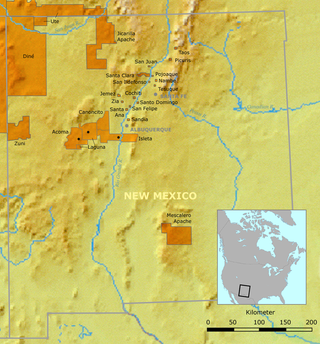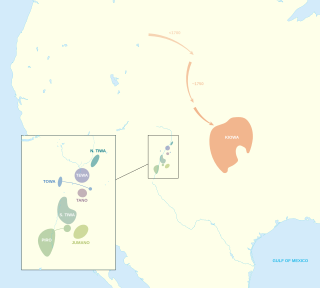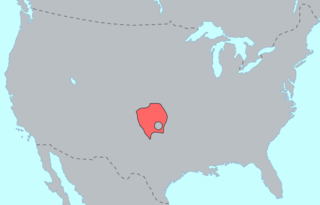Related Research Articles

The Puebloans, or Pueblo peoples, are Native Americans in the Southwestern United States who share common agricultural, material, and religious practices. Among the currently inhabited Pueblos, Taos, San Ildefonso, Acoma, Zuni, and Hopi are some of the most commonly known. Pueblo people speak languages from four different language families, and each Pueblo is further divided culturally by kinship systems and agricultural practices, although all cultivate varieties of maize.

Morris Swadesh was an American linguist who specialized in comparative and historical linguistics.
Tiwa is a group of two, possibly three, related Tanoan languages spoken by the Tiwa Pueblo, and possibly Piro Pueblo, in the U.S. state of New Mexico.
Piro people were a Native American tribe who lived in New Mexico during the 16th and 17th century. The Piros lived in a number of pueblos in the Rio Grande Valley around modern Socorro, New Mexico, USA. The now extinct Piro language may have been a Tanoan language. Numbering several thousand at the time of first contact with the Spanish, by the time of the Pueblo Revolt in 1680 the Piro had been decimated by European-introduced diseases and Apache attacks and most of the survivors resettled near El Paso, Texas.

Tanoan, also Kiowa–Tanoan or Tanoan–Kiowa, is a family of languages spoken by indigenous peoples in present-day New Mexico, Kansas, Oklahoma, and Texas.

Zuni is a language of the Zuni people, indigenous to western New Mexico and eastern Arizona in the United States. It is spoken by around 9,500 people, especially in the vicinity of Zuni Pueblo, New Mexico, and much smaller numbers in parts of Arizona.

Kiowa or Cáuijògà/Cáuijò:gyà is a Tanoan language spoken by the Kiowa Tribe of Oklahoma in primarily Caddo, Kiowa, and Comanche counties. The Kiowa tribal center is located in Carnegie. Like most North American indigenous languages, Kiowa is an endangered language.
Harry Hoijer was a linguist and anthropologist who worked on primarily Athabaskan languages and culture. He additionally documented the Tonkawa language, which is now extinct. Hoijer's few works make up the bulk of material on this language. Hoijer was a student of Edward Sapir.

Ysleta del Sur Pueblo, also Tigua Pueblo, is a Native American Pueblo and federally recognized tribe in the Ysleta section of El Paso, Texas. Its members are Southern Tiwa people who had been displaced from Spanish New Mexico from 1680 to 1681 during the Pueblo Revolt against the Spaniards.
George Leonard Trager was an American linguist. He was the president of the Linguistic Society of America in 1960.
The Tiwa or Tigua are a group of related Tanoan Puebloans in New Mexico. They traditionally speak a Tiwa language, and are divided into the two Northern Tiwa groups, in Taos and Picuris, and the Southern Tiwa in Isleta and Sandia, around what is now Albuquerque, and in Ysleta del Sur near El Paso, Texas.

The Taos language of the Northern Tiwa branch of the Tanoan language family is spoken in Taos Pueblo, New Mexico.
Taos is a Tanoan language spoken by several hundred people in New Mexico, in the United States. The main description of its phonology was contributed by George L. Trager in a (pre-generative) structuralist framework. Earlier considerations of the phonetics-phonology were by John P. Harrington and Jaime de Angulo. Trager's first account was in Trager (1946) based on fieldwork 1935-1937, which was then substantially revised in Trager (1948). The description below takes Trager (1946) as the main point of departure and notes where this differs from the analysis of Trager (1948). Harrington's description is more similar to Trager (1946). Certain comments from a generative perspective are noted in a comparative work Hale (1967).
Picuris is a language of the Northern Tiwa branch of Tanoan spoken in Picuris Pueblo, New Mexico.
The Southern Tiwa language is a Tanoan language spoken at Sandia Pueblo and Isleta Pueblo in New Mexico and Ysleta del Sur in Texas.

Aztec–Tanoan is a hypothetical and undemonstrated language family that proposes a genealogical relation between the Tanoan and the Uto-Aztecan families. In some forms, Aztec–Tanoan has also included the Zuni isolate. This proposed classification has not been definitively demonstrated, largely because of slow progress in the reconstruction of the intermediate stages of the two language families involved, but is still considered promising by many linguists. The grouping was originally proposed by Edward Sapir in his 1921 classification, but it was not until 1937 that supporting evidence was published by Benjamin Lee Whorf and G. L. Trager. Their proposal included some 67 proposed cognates, but subsequent reviews have found most of them to be unconvincing. A small number of their proposed cognates do seem to have some merit and in his 1997 review of the hypothesis Lyle Campbell states that the proposal is not implausible but requires detailed study. A recent article by Jane H. Hill argues that the evidence cited for the genetic relation by Whorf and Trager is better understood as a result of language contact between the Uto-Aztecan and Tanoan proto-languages.

Abó, is a pueblo ruin in New Mexico that is preserved as part of the Salinas Pueblo Missions National Monument. The ruins are located about 9 miles (14 km) west of Mountainair, at about 6,100 feet (1,900 m) above sea level. They are said to date back to the 14th century. It was a major trading station during its time. There is a visitor contact station, a 0.25 miles (0.40 km) trail through the mission ruins, and a 0.5 miles (0.80 km) trail around the unexcavated pueblo ruins. The site was declared a National Historic Landmark in 1962.
The Pueblo linguistic area is a Sprachbund consisting of the languages spoken in and near North American Pueblo locations. There are also many shared cultural practices in this area. For example, these cultures share many ceremonial vocabulary terms meant for prayer or song.
Frances Jane Hassler Hill was an American anthropologist and linguist who worked extensively with Native American languages of the Uto-Aztecan language family and anthropological linguistics of North American communities.
Solteco Zapotec is an extinct Zapotec language of western Oaxaca, Mexico. It was perhaps the most divergent Zapotec language.
References
- ↑ Piro at MultiTree on the Linguist List
- 1 2 3 4 5 Harrington, John P. (12 October 1909). "Notes on the Piro Language". American Anthropologist. 11 (4): 563–594. doi: 10.1525/aa.1909.11.4.02a00030 .
- ↑ Newman, Stanley (1954) "American Indian Linguistics in the Southwest" American Anthropologist New Series, 56(4): pp. 626-634, 631
- ↑ Leap, William L. (1971) "Who Were the Piro?" Anthropological Linguistics 13: pp. 321-330
- ↑ Bartlett, John Russell (9 July 1909). "The Language of the Piro". American Anthropologist. 11 (3): 426–433. doi:10.1525/aa.1909.11.3.02a00060 . Retrieved 3 July 2022.